People leave jobs for big reasons, like pay, fit, commutes, and for small ones that quietly pile up: a missed thank-you, a manager who never notices, a culture that prizes busyness over good work.
Recognition won’t solve every workplace problem, but it consistently makes a difference. When people feel seen, they’re more likely to stay, put in extra effort, and keep doing the things that matter most to the team.
To give you a quick yardstick: Gallup’s longitudinal work finds that employees who receive high-quality recognition are about 45% less likely to leave over two years.
Other large studies report that organizations with steady recognition report roughly a 31% reduction in voluntary turnover, and that 53% of workers say they’d stay longer if they felt more appreciated.
This article gathers the clearest, source-backed statistics you can use in planning, budgeting, or a board-level conversation. Expect compact, citable items, the numbers themselves, short context where it helps, and links to the original research so you can quote or model ROI.
Read it as a practical ammunition box: the facts you’ll need when someone asks whether recognition is feel-good or a measurable business lever.
Editor’s Choice:
- Employees who receive high-quality recognition are 45% less likely to leave within two years.
- Employees who feel meaningfully recognized are nearly 6× more likely to see a long-term future at their company.
- Employees who believe they will be recognized are 2.7× more likely to be highly engaged.
- 53% of employees say they would stay longer if they received more appreciation.
- Recognition programs can save a 10,000-person company up to $16.1M annually in turnover costs.
Engagement Baseline & Context
Before you can measure the value of recognition, you need to understand the environment it operates in. Employee engagement has been slipping in both the U.S. and globally, creating a weak foundation for productivity and culture.
These numbers show the urgency of using recognition as a lever to lift energy and offset the steep costs of disengagement.
U.S. employee engagement rate: 31% engaged (2024).
Gallup’s 2024 data show only 31% of U.S. employees report being engaged, a ten-year low. That low baseline matters: recognition programs must start from a weaker place of commitment and energy, so small, regular interventions are more likely to register and compound. Source: Gallup.com
Global employee engagement rate: 21% (2024).
Gallup’s 2024 data show global engagement slipped to 21%, reinforcing the need for low-lift, high-frequency levers like recognition to move the needle. Source: Gallup.com
The cost of disengagement: $8.8T globally.
Gallup estimates low engagement costs $8.8 trillion in lost productivity (9% of global GDP).

Motivation & Repeat Behaviour
Recognition doesn’t just feel good; it changes how people show up at work. When employees are noticed, they’re more likely to put in extra effort, repeat the right behaviors, and feel a stronger connection to the team.
The following stats highlight how even simple, frequent recognition multiplies motivation and belonging.
Recognition motivates extra effort; 91% report more effort.
In Achievers’ latest workforce survey, 91% of employees said recognition makes them more willing to go the extra mile.
In practice, that means the late-night troubleshooting, the quick help for a teammate, or the customer call no one asked for, exactly the moments that keep projects moving.
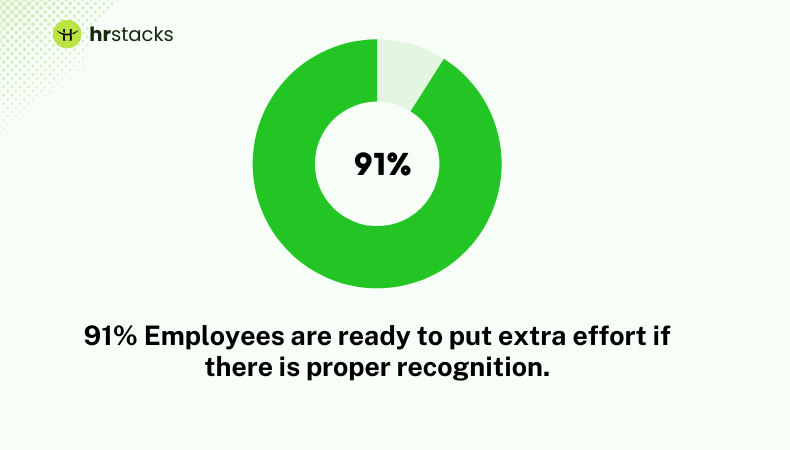
Recognized behaviours repeat; 92% likely to repeat actions that were praised.
Recognition doesn’t just feel good; it shapes habits. Multiple vendor studies report 92% of employees say they’ll repeat a behavior if it was acknowledged, a simple way for managers to remind people to work together, stay safe, or keep customers front and center. Source: Awardco
Weekly recognition lifts perceived peak productivity 2.6×.
Achievers finds employees recognized weekly are 2.6× more likely to say they’re operating at their most productive.
Weekly recognition boosts belonging 9×.
Regular, weekly recognition is associated with a 9× jump in employees reporting a strong sense of belonging.
Retention & Turnover
Few areas show the impact of recognition as clearly as retention. When people feel appreciated, they stay longer, quit less often, and bring more stability to teams.
These figures demonstrate just how powerful recognition is as a safeguard against costly turnover and a driver of long-term loyalty.
Well-recognized employees: 45% less likely to have left two years later.
Gallup / Workhuman longitudinal tracking shows employees who received high-quality recognition in 2022 were 45% less likely to leave by 2024, a concrete signal that strategic recognition has a durable effect on retention, not just short bursts of morale.
Companies with strong recognition report 31% lower voluntary turnover.
Research has found that companies with strong recognition programs see turnover drop by about 31%. That’s a meaningful difference, enough to impact recruiting budgets and team stability.
Employees who aren’t recognized are 2× more likely to say they’ll quit within a year.
Gallup and related studies find the absence of recognition doubles near-term quit intent, a clear warning sign. When people don’t feel recognized, they don’t just get frustrated; they start planning to leave.
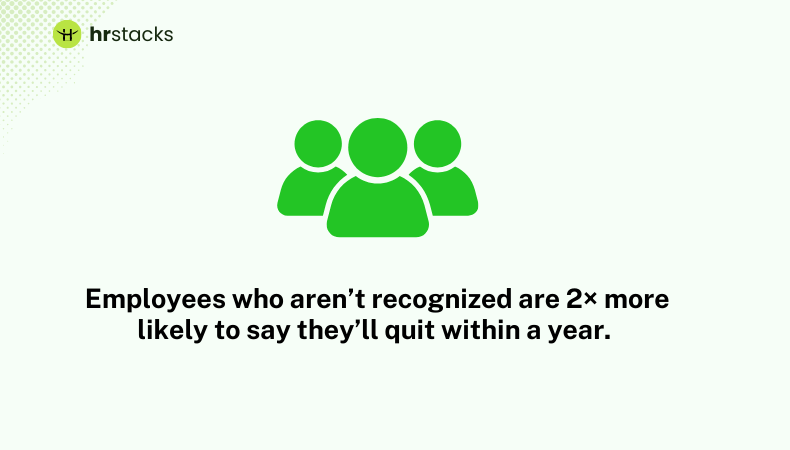
Consistent recognition can add 3.5 years to average tenure.
O.C. Tanner’s analyses suggest regular, meaningful appreciation increases average tenure by roughly 3.5 years, a long-range retention effect you can model into headcount and knowledge-retention forecasts.
Employees who feel appreciated are 5× more likely to stay.
Survey and white-paper evidence from O.C. Tanner and similar institutes show that people who feel genuinely appreciated are several times likelier to remain; this is an effect on intent and behavior, not just sentiment scores. Source: O.C. Tanner
Recognized new hires are 2× less likely to quit in their first year.
Early recognition during onboarding substantially improves first-year retention. Workhuman and client case studies report recognized new hires have roughly half the early attrition of unrecognized cohorts, valuable when early turnover eats recruiting budgets.
Meaningful recognition strengthens long-term intent to stay (6×).
Achievers reports employees who feel meaningfully recognized are nearly 6× more likely to see a long-term future at their company.
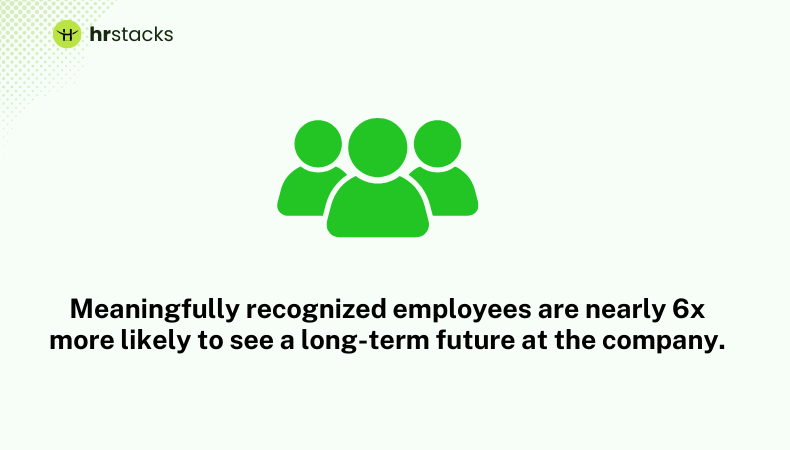
Program Design & Frequency
Not all recognition is equal. The timing, frequency, and source of appreciation determine whether it lands or falls flat.
The data below show why weekly recognition is far more powerful than monthly, why managers matter so much, and how peer-to-peer programs add fairness and scalability.
Weekly and monthly recognition deliver markedly different outcomes.
Achievers’ State of Recognition finds weekly meaningful recognition multiplies belonging and productivity (weekly recognition = 9× belonging, 2.6× peak productivity); monthly recognition still helps, but to a smaller degree. Frequency and sincerity matter more than grandiosity.
Manager-delivered recognition is the most potent channel, but it’s often missing.
Reports show manager praise has an outsized impact (trust, belonging, productivity), yet many organizations see manager recognition rates decline. Programs fail when managers don’t practice recognition; coach the manager, don’t just buy a platform.
Peer recognition scales fairness and engagement.
Peer-to-peer programs (points, public shout-outs) increase perceived equity and engagement. Report suggests peer recognition boosts employer brand and can drive financial growth more effectively than manager-only praise in some settings. That’s why social recognition is now common.
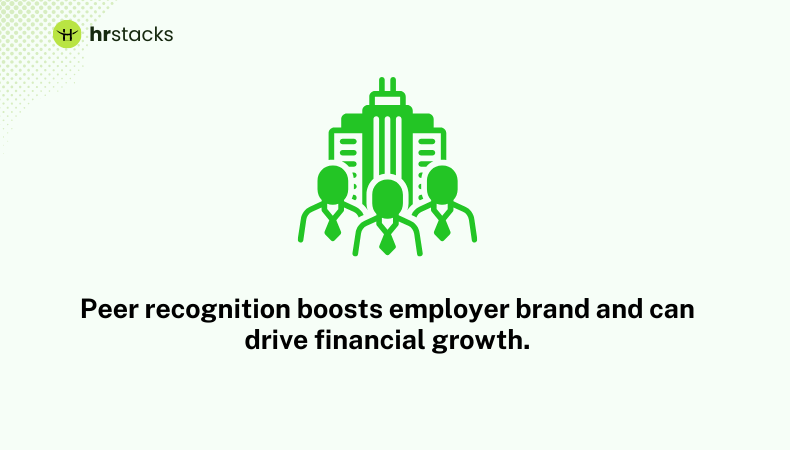
Recognition must be meaningful and specific; timing matters.
Recognition works best when it’s specific and timely. O.C. Tanner’s research shows that a quick, genuine “thank you” tied to a concrete action has a much bigger impact than a generic pat on the back weeks later.
Manager recognition matters; frequency is the force multiplier.
Gallup/Workhuman emphasizes strategic, frequent recognition (who recognizes, how, and how often) as the differentiator between noise and impact.
Weekly > monthly for culture outcomes.
Achievers data show step-changes (e.g., belonging, productivity) when recognition is weekly, not just monthly.
Feedback, Belonging & Engagement Multipliers
Recognition doesn’t work in isolation. Paired with feedback, it strengthens engagement; delivered consistently, it builds belonging and trust. These stats reveal how recognition interacts with broader cultural drivers, creating compounding effects across teams.
Valuable feedback and recognition multiply engagement (5× effect).
Gallup and Workhuman show that employees who strongly agree they get valuable feedback from colleagues are about five times more likely to be highly engaged. Recognition plus feedback forms a virtuous loop that drives sustained engagement.
Expectation of recognition raises engagement (Quantum Workplace: 2.7×).
Quantum Workplace finds that simply believing you’ll be recognized makes employees 2.7 times more likely to be highly engaged, meaning culture beats a surprise award. Source: Quantum Workplace
Recognition builds belonging and trust quickly.
Achievers and others report that frequent recognition multiplies belonging and manager trust (weekly recognition moves belonging by multiples; manager recognition increases trust and alignment). Belonging shows up fast and sustains engagement.
Productivity, Business Outcomes & ROI
Recognition isn’t just a culture boost; it produces measurable business results. From productivity and safety to absenteeism and turnover savings, recognition programs deliver clear ROI. The numbers here provide the kind of evidence finance and leadership teams look for when weighing investments.
Deloitte: 14% higher engagement, productivity, and performance where recognition occurs.
Deloitte’s analysis shows organizations that systematically recognize employees report roughly a low-double-digit uplift (14%) in engagement, productivity, and performance, a useful benchmark for ROI conversations. Source: Deloitte
Gartner: 11% boost in average employee performance from good recognition programs.
Gartner’s research is often quoted by HR vendors, and for good reason; it highlights how recognition links directly to business results
Recognition investment can save real dollars, up to $16.1M for a 10,000-person firm.
Gallup and Workhuman estimate that a 10,000-person company could save around $16 million a year in turnover costs by making recognition part of everyday culture. Numbers like that usually make executives sit up and take notice.
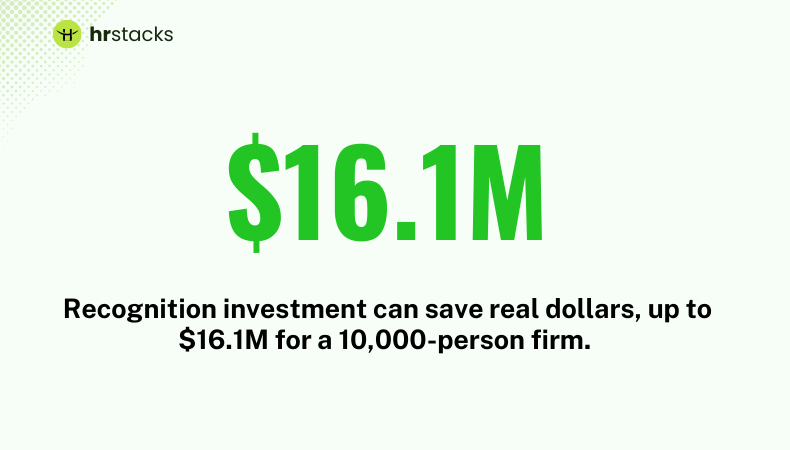
Modest recurring investments often pay back via reduced turnover and higher output.
Workhuman, O.C. Tanner, and vendor ROI pieces show that even modest, repeated spend on recognition tends to yield payback through lower hiring costs and improved productivity, tested with conservative turnover-cost assumptions.
Recognition improves productivity, safety, and absenteeism.
Gallup–Workhuman modelling shows that increasing “recognition that hits the mark” correlates with higher productivity, fewer safety incidents, and lower absenteeism; some analyses quantify improvements near 9% productivity and 22% reductions in safety incidents/absenteeism (organization-dependent).
Recruitment, Employer Brand & Reasons To Leave
Recognition also shapes how people outside the company see you. It improves employer brand, attracts candidates, and prevents resignations tied to a lack of appreciation. These stats highlight why recognition matters just as much in hiring and reputation as it does in retention.
Recognition helps hiring and the employer’s reputation.
SHRM, vendor syntheses, and employer case studies show recognition programs improve employer brand and candidate attraction; public recognition and peer praise surface in candidate research as differentiators.
A large share cite “lack of appreciation” as a reason to quit (some surveys: 55-79%).
O.C. Tanner and other surveys consistently place a lack of appreciation high among exit reasons; many respondents report it as one of the top factors driving resignations. Percent ranges vary by study and phrasing.
Many employees say extra appreciation would make them stay or work harder (50–70%).
Across vendor and independent surveys, a substantial portion (roughly half, sometimes up to 70%) say more appreciation would increase their intent to stay or willingness to put in more effort, a direct measure of program influence on intent.
Practical Resourcing & Design Rules
Even with the best intent, recognition needs resourcing. Industry benchmarks suggest how much to budget and how to structure programs for scale.
Budget/reference rules: 1% of payroll is a common benchmark for recognition spend.
SHRM, Inspirus, and industry guides often present 1% of payroll (or 1–2%) as a funding rule of thumb for meaningful, company-wide rewards and recognition programs. Use it as a starting point and model for your headcount and goals.
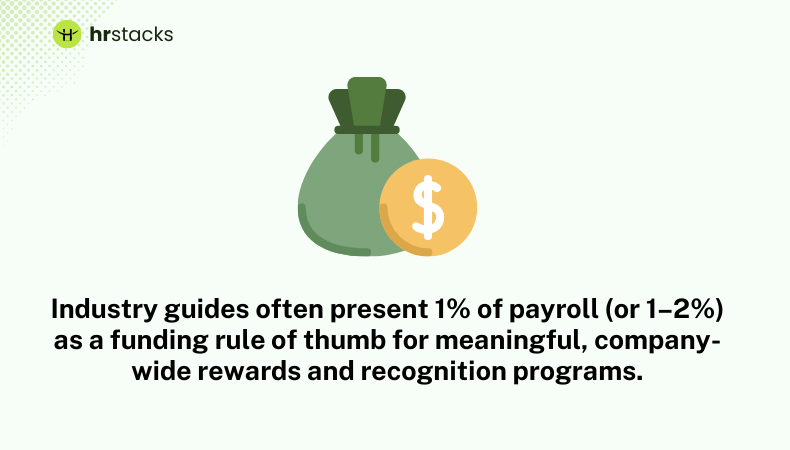
What To Do Next: Three Quick Actions
Start small and make recognition routine, like short, specific praise given weekly or monthly, delivers far bigger engagement returns than occasional, grandiose awards.
Treat recognition like a business program: track recognition frequency against retention and performance, and invest in manager coaching while enabling easy peer-to-peer shout-outs through lightweight platforms.
- Make recognition frequent and specific. Weekly or monthly specific praise beats annual awards.
- Measure outcomes, not applause. Track recognition frequency against retention, time-to-fill, and performance metrics.
- Coach managers and enable peers. Platforms help scale, but manager practice and peer systems drive results.
Conclusion
Recognition isn’t just a feel-good tidbit; it’s something that actually moves the needle on results, not just culture. If your engagement metrics feel flat or turnover costs keep climbing, recognition offers a low-cost fix with proven returns.
Gallup’s research shows recognized employees are 45% less likely to leave, not a one-off morale bump, but sustained retention. Other studies show organizations with strong recognition enjoy about 31% lower voluntary turnover and performance gains of roughly 11% from structured programs.
When praise is frequent, specific, and driven by managers and peers, engagement multiplies and behaviors stick. In short, recognition delays exits, unlocks effort, and builds lasting culture, one genuine “thank you” at a time.









